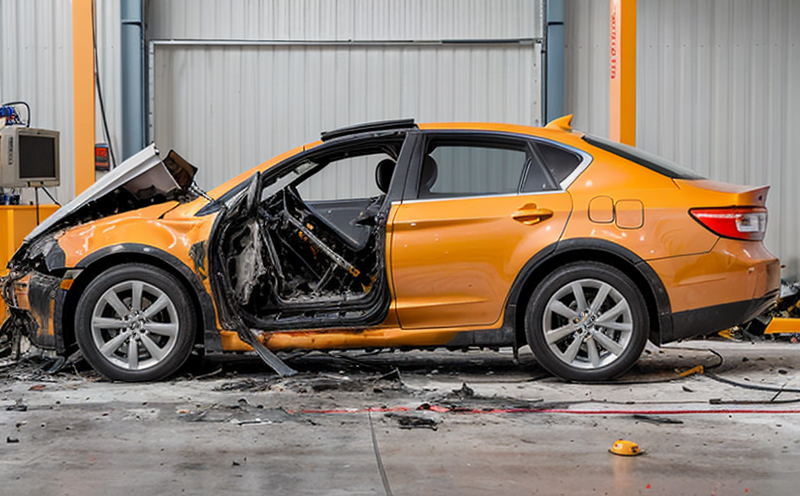IEC 61982-4 Crash and Mechanical Abuse Testing of Rechargeable Batteries for Electric Road Vehicles
The International Electrotechnical Commission (IEC) standard, IEC 61982-4, specifies the procedures for crash and mechanical abuse testing of rechargeable batteries intended for use in electric road vehicles. This service ensures that the batteries meet stringent safety requirements under various abusive conditions, such as impact, vibration, and temperature cycling.
The primary goal of this test is to evaluate a battery's resilience against real-world hazards encountered during vehicle operation. These include collisions with obstacles, road debris, or other vehicles, which can cause mechanical stress on the battery pack. By simulating these scenarios in a controlled environment, manufacturers can identify potential weaknesses and improve the overall safety and reliability of electric vehicle (EV) batteries.
The testing protocol outlined in IEC 61982-4 covers multiple types of abuse tests, including:
- Drop Test: The battery is subjected to a specified height drop onto a flat surface or an edge. This simulates the impact from falling objects or rough terrain.
- Vibration Test: The battery undergoes controlled vibration within specific frequency and amplitude ranges, mimicking the dynamic environment encountered in moving vehicles.
- Thermal Shock Test: Batteries are exposed to rapid temperature changes between extreme hot and cold conditions, testing their thermal stability and integrity.
- Voltage Transient Test: This tests the battery's response to sudden voltage fluctuations that can occur due to power surges or load variations.
The testing process involves meticulous preparation of the specimen. The battery pack is carefully assembled according to manufacturer specifications, ensuring that all components are in optimal condition before undergoing any abuse. During the test, real-time monitoring ensures accurate data collection and compliance with IEC standards.
Once the testing is complete, a comprehensive report is generated detailing every aspect of the test, including:
- The type and severity of each abusive condition applied to the battery
- Data on temperature changes during thermal shock tests
- Voltage measurements from voltage transient tests
- Visual inspection results for any visible damage or signs of failure
- Performance metrics before, during, and after testing
This detailed report serves as a crucial tool for manufacturers to assess the performance and safety features of their batteries. It also provides valuable insights that can be used to enhance design and manufacturing processes.
The importance of this test cannot be overstated in the context of electric vehicle development. Electric vehicles are increasingly gaining popularity due to environmental and economic benefits, but they also present unique challenges related to battery safety. By adhering to IEC standards like IEC 61982-4, manufacturers can ensure that their products meet global safety regulations and customer expectations.
Compliance with these standards not only enhances the reputation of a company but also fosters trust among consumers, regulatory bodies, and other stakeholders. This service is particularly relevant for electric vehicle manufacturers, battery suppliers, and quality assurance professionals who are committed to delivering safe and reliable products.
Why It Matters
The safety of electric vehicles depends significantly on the reliability and durability of their batteries. IEC 61982-4 provides a standardized method for assessing how well these batteries withstand mechanical abuse, which is critical in ensuring that they perform safely under real-world conditions. This standard helps prevent potential hazards associated with battery failures, such as overheating, short circuits, or even explosions.
By conducting crash and mechanical abuse tests according to IEC 61982-4, manufacturers can:
- Avoid costly recalls: Early identification of design flaws through rigorous testing helps prevent issues that could lead to product recalls.
- Increase market confidence: Compliance with global standards enhances consumer trust and supports the growth of electric vehicle markets.
- Ensure regulatory compliance: Many regions have safety regulations that require adherence to IEC standards, making this testing essential for entering new markets.
- Promote innovation: The insights gained from these tests can drive continuous improvements in battery technology and design.
In summary, IEC 61982-4 plays a vital role in safeguarding public safety and fostering the development of sustainable electric vehicle technologies.
Why Choose This Test
- Promotes Safety: Ensures that batteries can withstand real-world mechanical abuse, reducing risks associated with EV accidents.
- Enhances Reliability: Identifies potential weaknesses in battery design and construction, leading to more robust products.
- Facilitates Compliance: Helps manufacturers meet international safety regulations and standards.
- Supports Innovation: Provides valuable data that can be used to improve battery performance and durability.
- Achieves Efficiency: By identifying issues early in the development process, this testing helps avoid costly modifications later on.
- Fosters Trust: Demonstrates a commitment to safety and quality, which is essential for building customer confidence.
Choosing IEC 61982-4 crash and mechanical abuse testing ensures that your products meet the highest safety standards while also positioning your company at the forefront of electric vehicle technology.
International Acceptance and Recognition
The importance of international acceptance in global markets cannot be overstated. IEC 61982-4 crash and mechanical abuse testing is widely recognized across various countries, ensuring that your products meet the stringent requirements set by regulatory bodies worldwide.
Countries like the United States, Europe, China, Japan, and South Korea have adopted these standards as part of their vehicle safety regulations. This means that compliance with IEC 61982-4 can help you expand into new markets more easily while maintaining a consistent level of quality across all regions.
By adhering to this standard, manufacturers demonstrate not only their commitment to safety but also their ability to meet international standards. This is particularly important for electric vehicle manufacturers who are entering the global market or expanding into regions with stringent safety requirements.





